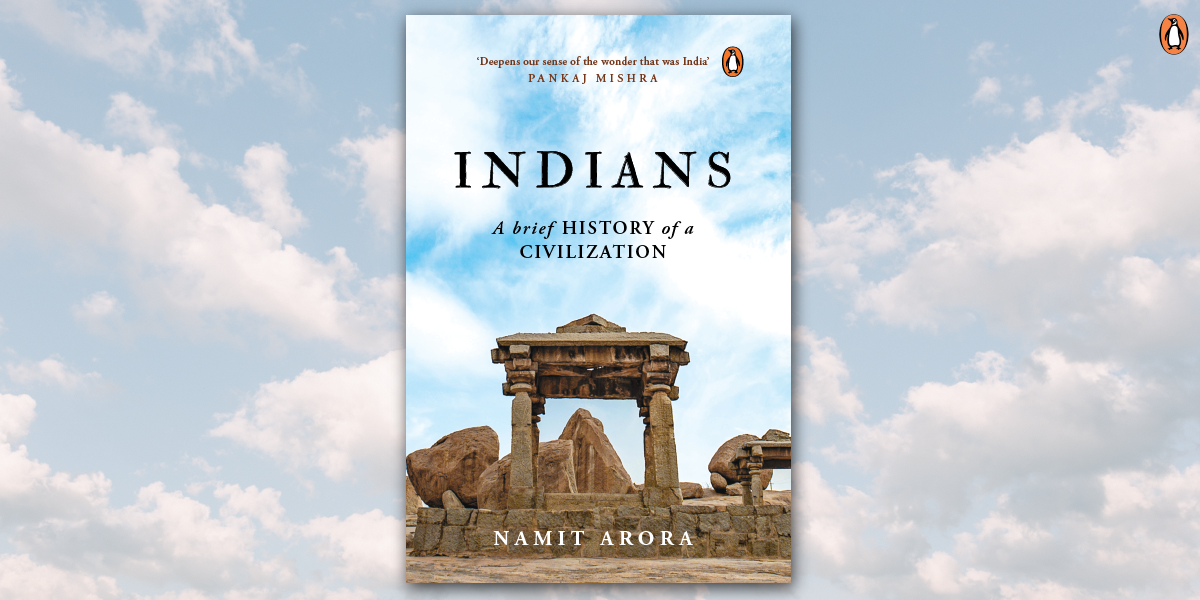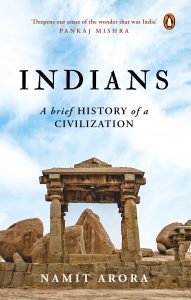
Indian civilization is an idea, a reality, an enigma. In the riveting INDIANS: A Brief History of a Civilization, Namit Arora takes us on an unforgettable journey through 5000 years of history, reimagining in rich detail the social and cultural moorings of Indians through the ages. Enlivening the narrative with the idiosyncratic perspectives of the many famous foreign travellers who visited India over millennia, local folklore and his own inimitable insights, Arora guides us through six iconic places-the Harappan city of Dholavira, the Ikshvaku capital at Nagarjunakonda, the Buddhist centre of learning at Nalanda, enigmatic Khajuraho, Vijayanagar at Hampi, and Varanasi.
Read on for a glimpse into the exciting churn of ideas, beliefs and values that unfolded among our ancestors through the centuries.

Still, the lack of loud and clear indicators of war or standing armies, so commonplace in other civilizations, is a striking feature of the Harappan Civilization. Further, Harappan cities have not revealed monumental, or even humble, temple structures, a great puzzle for scholars. There aren’t any equivalents of the temples and pyramids of ancient Egypt or the ziggurats of Mesopotamia. Some say the Great Bath of Mohenjo-Daro had a religious purpose but this is highly speculative. Or perhaps the Harappans built religious shrines and large sculptures from perishable materials like wood. In any case, while there are hints, we have no clear sense of Harappan gods and rituals, or whether they had any temples or priests. Scholars have offered divergent interpretations of seals with possible religious content: a handsome seven-inch sculpture of a man named ‘priest-king’, who could well have been an aristocrat; a seal named ‘proto-Shiva’ that depicts a multi-headed, seated figure in a yoga-like pose, one of ‘several other yogi images in the corpus of Mature Harappan materials’; another seal that shows a female (deity?) standing under a Bodhi tree with its heart-shaped leaves, a figure kneeling before her in supplication and seven standing figures watching them; other seals that depict mysterious objects and rituals before a unicorn; the swastika motif appears often; some female figurines have a paste-like substance along the middle parting of their hair; a stone object in the shape of a phallus has been identified; two terracotta male figurines have erections; a small terracotta object in Kalibangan resembles the familiar Shiva lingam. All this is very tantalizing. There can be little doubt about cultural continuities. Harappan beliefs clearly shaped later religions of the Axial Age in the subcontinent. Quite possibly, Indian ideas of meditation and even renunciation have Harappan origins. But it’s difficult to draw firm conclusions about this, or about what the Harappans themselves believed, at least until the script begins to speak. Scepticism is essential: The deciphered Mayan script revealed how wrong many scholars were about the beliefs they had attributed to the Mayans (such as being peaceful). The Harappans did not build monumental sculptures, such as of kings or gods, as did the Mesopotamians and the Egyptians. This doesn’t make them any less complex than others, writes Possehl, rather it’s an alternative way in which a civilization, with a ‘highly complex sociocultural system, has expressed itself’. They did make fine miniature art, as in seals and beadwork. And while their figurines aren’t notable for their artisanship, they still evocatively depict their people ‘in great variety, with many poses: sitting in chairs, lying on beds, holding babies and animals, kneading bread, and other things that people do to round out their existence,’ writes Possehl. Animal puppets, in which a bull might shake its head or pull a cart, reveal a playful sense of humour, perhaps designed to amuse children. There are some fantasy creatures too, but ‘on the whole, the Indus peoples in their art, as in other aspects of their lives, come across as people with a practical bent, a tendency to deal with and represent the real world as they [and we] see it’. That said, what jumps out as the Harappans’ greatest monumental work is the city itself, a marvel of urban design and engineering, city- wide sanitation systems that include the first indoor toilets in the world and sophisticated water management. ‘Probably not until later Roman times did people devise so many clever construction techniques to deal with comforts and discomforts related to water.’ They also excelled at shipbuilding and long-distance trade—another reason to think that they had centralized authority and bureaucracy to mobilize labour, develop trading networks and organize long-distance shipping expeditions. Harappan cities of the mature period (2600–1900 bce) had some walled neighbourhoods with larger buildings and better provisions, suggesting that an elite class resided there. But not everyone agrees. There is ‘no justification’ or archaeological support for this presumption, says archaeologist Jonathan Mark Kenoyer. In fact, in certain stages, the ‘citadels’ in Dholavira and Mohenjo-Daro were hubs of artisanal– industrial activity. There is no evidence of royal palaces; homes differ in size and provisions but not by much. Sanitation and water wells were available to all. Based on the bones of the dead, the rich and the poor seem to have enjoyed similar access to nutrition. Their burials too display a narrow range in their sizes and types of funerary objects. However, as noted earlier, burial practices may have varied across individuals, or social groups. That the Harappans had a social social class hierarchy is clear enough. What’s remarkable is that this hierarchy seems so much flatter than in other ancient (or modern) civilizations.
Get your copy now for a truly epic exploration of the cultural behemoths that continue to shape ‘INDIANS’ today https://www.amazon.in/Indians-History-Civilization-Namit-Arora/dp/0670090433









